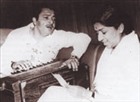


As the strains of Do pal rukaa from Veer-Zaara (2004) filtered through the transom of contemporary Hindi film music onto the eager ears, one could feel the strong sense of musical deja vu. Been here, heard that. The voice, having weathered almost a half century, was now paying one last tribute. The composition, not to be left behind, was acknowledging their historic collusion. And while Madan Mohan-Lata Mangeshkar weaved one more strand of their magical fabric, the goose bumps stood up in rapturous applause.
Like O.P. Nayyar once famously said, it is difficult to figure out whether Madan Mohan was made for Lata Mangeshkar or vice versa. But, he added, there has never been a composer like Madan Mohan or a singer like Lata. Naushad went on record saying he was ready to exchange all his compositions for the twin gems of Hai isi mein pyaar ki aabroo and Aap ki nazron ne samjha from Anpadh (1962). S.D. Burman marvelled at his use of Lata’s vocals in tandem with folk instruments in Heer Ranjha (1970). Singers like Asha Bhosle, Kishore Kumar and Manna Dey waxed eloquent on the Lata-Madan combine. However, unfortunately, most of this adulation was truly Van Goghesque in nature. Madan Mohan couldn’t witness most of it in his lifetime.
The finest work, from Devendra Goel’s Aankhen (1950) to Hari Mehra’s jinxed Chaalbaaz released five years after the maestro’s death, of this vintage combination transcends time. Notwithstanding the phoenix of Veer-Zaara (2004), Madan Mohan scored music for about 90 films and collaborated 210 times with Lata Mangeshkar, primarily for solos. For a man who thought Lata was the nearest thing to vocal perfection he has heard, each of those 210 times must have been ecstasy.
Moving away from mere statistics, there is an obvious query which would plague most minds. That among the innumerable unforgettable partnerships the Nightingale had forged with the entire pantheon from Anil Biswas to A.R. Rahman, what makes this combination supreme? That, too, with a composer who was hardly a ‘commercial’ success? The answer exists at various levels. His compositional techniques and eventually the output were vastly different from most of his contemporaries, and even later composers. As Lata Mangeshkar reminisces, he used to croon various taans during the creation of a song. And his genius lay in etching out the final composition from the surfeit of these taans with the assured competency of a magician pulling a rabbit out of his hat.
Though primarily popular as the Ultimate Ghazal-smith, he fashioned an incredible range for the vocals of Lata, where the output was more than simply a ghazal. Furthermore, Lata also sounded different under Madan Mohan. One reason was that his composition often broke away from the usual paradigm of Hindi songs of a low octave mukhda followed by an antara at a higher octave. His compositions often started at a high pitch, followed either by an antara in low octave (for example, Jee humen manzoor hain from Aap ki nazron ne samjha) or an even higher pitched antara.
For the latter, sample the three beauties from Raj Khosla’s ghost saga Woh Kaun Thi? (1964) — Lag ja gale, Naina barse rimjhim and Jo hum ne daastaan. We find the extra intensity, that added involvement with the soul of the numbers which Lata had to eke out. His numbers often created a feel of tearful craving, simply by using one special note or line at an opportune moment. As in the use of one Lata stanza in Tum jo mil gaye ho (Hanste Zakhm). Or the dulcet caress of the ephemeral in Khelo na mere dil se (Haqeeqat, 1964) by using the very unconventional Teevra Madhyam note as the first note of the number, and restricting its use to only once in this number that lingers in raga Charukeshi.
Another aspect of his style which makes this collaboration stand out is the fusion of Western elements of orchestration with Indian sensibilities, a trait which received an initial fillip under masters like C. Ramachandra, O.P. Nayyar and Shankar-Jaikishan, and finally reached the zenith of unimaginable brilliance under Salil Choudhury and R.D. Burman.
While Salil could cast a spell with his juggling of the seven notes or RD could marry off unthinkable rhythms with smooth flowing tunes, Madan Mohan could play around with the soul of the number. His compositions were heavy, cavernous, resonant, yet razor-sharp. Though arrangement was never his strongest point, he was a perfectionist and ensured that his musicians always gave their best.
One incident which probably affirms this to the hilt is a part of film folklore by now. During the recording of Nainon mein badra chhaaye (Mera Saaya, 1966) when a musician hit a wrong note, true to his military background, his fragile temperament and his utter contempt for anything musically incompetent, he broke the glass pane of the recording room!
Madan Mohan was not an assembly-line composer, and most of his songs with Lata might not be instantly hummable. To fathom the intensity of his compositions, one has to give more than just a casual hearing. And this is probably what the last three decades of music lovers have increasingly realized; because the combination which once failed to set the popular imagination on fire is now a sure-shot for the music companies. Along with Lata-Salil, RD-Kishore and Asha-OP, Lata -Madan remains one of the best musical collusions of Hindi film music.
Best Of Lata – Madan Mohan
1 Lag ja gale
(Woh Kaun Thi?, 1964)
2 Betaab dil ki tamanna
(Hanste Zakhm, 1973)
3 Yoon hasraton ke daag
(Adalat, 1958)
4 Woh bhooli daastaan
(Sanjog, 1961)
5 Baiyyaan na dharo
(Dastak, 1970)
6 Khelo na mere dil se
(Haqeeqat, 1964)
7 Nainon mein badra chhaaye (Mera Saaya, 1966)
8 Na tum bewafa ho
(Ek Kali Muskayi, 1968)
9 Hai isi mein pyaar ki aabroo (Anpadh, 1962)
10 Raat ujiyari din andhera hai (Chalbaaz, 1980)